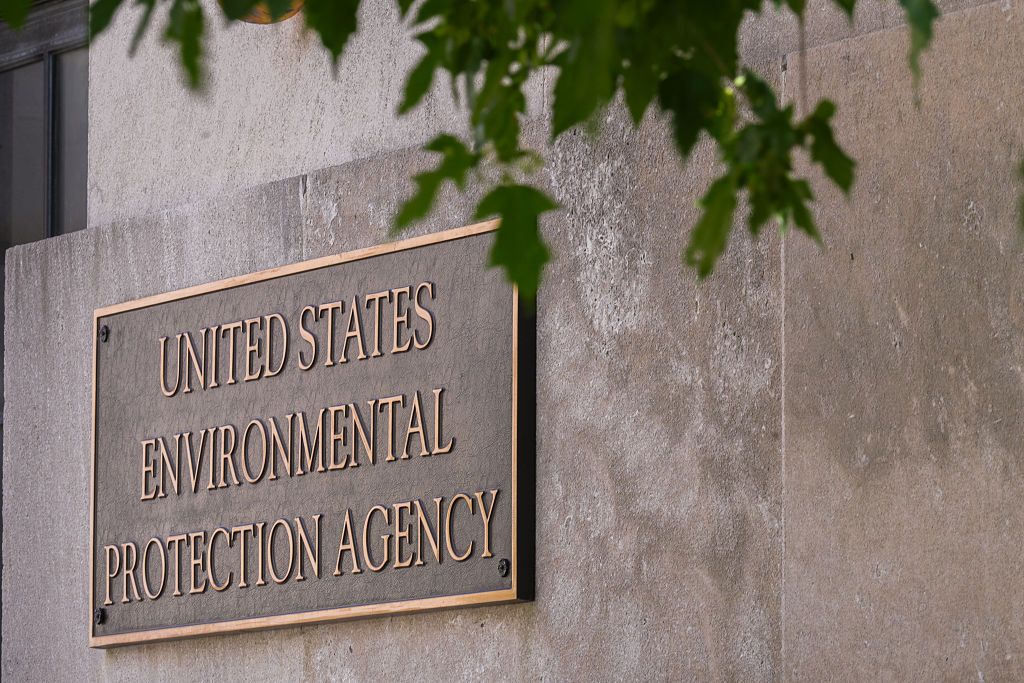In early May, the Environmental Protection Agency announced that it would split up the agency’s main arm devoted to scientific research. According to a report from NPR, scientists at the 1,500-person Office of Research and Development were told to apply to roughly 500 new scientific research positions that would be sprinkled into other areas of the agency—and to expect further cuts to their organization in the weeks to come.
This reorganization threatens the existence of a tiny but crucial program housed within this office: the Integrated Risk Information System Program, commonly referred to as IRIS. This program is responsible for providing independent research on the risks of chemicals, helping other offices within the agency set regulations for chemicals and compounds that could pose a danger to human health. The program’s leader departed recently, ahead of the restructuring announcement.
The EPA’s reorganization, experts say, will likely break up this crucial program—which has been targeted for decades by the chemical industry and right-wing interests.
“Unfortunately, right now, it looks like the polluters won,” says Thomas Burke, the founder and emeritus director of the Johns Hopkins Risk Sciences and Public Policy Institute and a former deputy assistant administrator of the EPA’s Office of Research and Development.
“The May 2 announcement is all part of a larger, comprehensive effort to restructure the entire agency,” EPA spokesperson Molly Vaseliou told WIRED in an email. “EPA is working expeditiously through the reorganization process and will provide additional information when it’s available.”
Formed in the mid-1980s, the IRIS program was designed to investigate the health impacts of chemicals, collating the best available research from across the world to provide analyses of potential hazards from new and existing substances. The program confers with other offices within the EPA to identify top chemicals of concern that merit further research and study.
Unlike other offices in the EPA, the IRIS program has no regulatory responsibilities; rather, it exists solely to provide science on which to base potential new regulations. Experts say this insulates IRIS-produced assessments from outside pressures that could influence research done in other areas of the agency.
“There’s independence” in being in a centralized program like IRIS, says Jennifer Orme-Zavaleta, also a former principal deputy assistant administrator of the Office of Research and Development and a former EPA science adviser. “They’re not trying to evaluate risk for a specific purpose. They’re just evaluating risk and providing fundamental information.”
Since its inception, IRIS has created a database of more than 570 chemicals and compounds with assessments of their potential human health effects. This body of research underpins not just federal policy, but helps guide state and international regulations as well.
The IRIS database is the “gold standard for health assessments for chemical pollutants,” says Burke. “Virtually all of our regulated pollutants, virtually all of our cleanups, virtually all of our major successes in regulating toxic chemicals were touched by IRIS or the IRIS staff.”
Yet IRIS has faced a significant uphill battle in recent years. For one, there’s the sheer number of chemicals it has had to review with limited manpower. There are more than 80,000 chemicals that have been registered for use in the US, and chemical companies register hundreds more each year. Some of the chemicals IRIS is working to research have been substances of concern for years, while some have more recently drawn new scrutiny. For instance, forever chemicals—synthetic materials so named because of their persistence in the environment—have been in use for decades, but their recent prevalence in tests of water and soil prompted IRIS in 2019 to begin creating draft assessments for five common types of these chemicals.
Opposition from industry has also bogged down IRIS reviews. The very existence of the IRIS program, experts say, threatens many crucial chemicals used by a variety of industries. A new IRIS assessment finding that a specific chemical that’s been in use for years is carcinogenic, for instance, could hamper industries that rely on that chemical if the EPA decides to pass new regulation. Chemical companies and lobbying groups have waged a long battle against the IRIS program, using various tactics—including introducing opposing research produced by paid consulting groups—to downplay the program’s findings and delay assessments. In 2018, for instance, The Intercept reported that an environmental consulting company that counts chemical giants among its clients challenged an IRIS assessment of chloroprene, a chemical used in rubber production. The program was forced to use resources and staff time putting together an extensive response defending its analysis.
“‘Hate the policy, attack the science’ became a strategy for many major industries,” says Burke. “They learned that the delay game of attacking the science led to the delay of implementing regulation.”
President Donald Trump’s first administration also tried to attack IRIS. A 2018 Senate appropriations bill suggested eliminating IRIS’s independence by folding it into another program within the EPA. IRIS also faced challenges from new leadership inside the EPA, including Nancy Beck, a former policy director at the American Chemistry Council (ACC), the main lobbying arm for the chemical industry, who oversaw the EPA’s office of chemical regulation between 2017 and 2020. Yet Congress eventually chose to fund the program that year, and the general structure of IRIS survived past the first Trump administration.
But with such a long track record of opposition—and with Trump’s second administration ripping up entire agencies—it’s perhaps unsurprising that IRIS is on the chopping block now. The program was singled out twice in Project 2025. IRIS has also been attacked by legislation introduced in Congress this session, called the No IRIS Act. A press release for the House bill quotes the CEO of ACC, who also authored an op-ed in the Washington Examiner in March calling on the agency to eliminate the program.
In a separate press release issued last week, the ACC lauded EPA administrator Lee Zeldin’s choice to reorganize the agency. While the EPA has made no public comment about the future of the IRIS program, the press release devotes two paragraphs to IRIS, claiming that the program’s assessments “jeopardize access to critical chemistries, undercut national priorities, and harm American competitiveness,” while asserting the ACC’s support for the No IRIS Act.
“The IRIS program has never been authorized by Congress, and since 2009 the program has remained on the [Government Accountability Office’s] High-Risk List, which identifies government programs that are vulnerable to fraud, waste, abuse, or mismanagement,” the ACC press release states. But in the original High-Risk List addition in 2009, the GAO stated that it added IRIS not over concerns of fraud or abuse, but because the program was not working through analyses of harmful chemicals fast enough to protect the public. “Some of the IRIS assessments that have been in progress the longest cover key chemicals likely to cause cancer or other significant health effects,” the 2009 listing states. Several reforms since then, the GAO report states, have improved the program. GAO’s current critiques of IRIS, updated in 2025, focus mainly around a lack of staff and budget needed to speed up reviews.
Tom Flanagin, a spokesperson from the American Chemistry Council, told WIRED in an email that the group believes “the IRIS program should be disbanded and the responsibilities of the program should be returned to the program offices” and that Congress should pass the No IRIS Act.
“IRIS assessments jeopardize access to critical chemistries, undercut national priorities, and harm American competitiveness,” Flanagin added.
If IRIS is eliminated, experts say, EPA research on toxic chemicals will continue—but the work will likely be siloed to offices dealing with specific aspects of the environment. Instead of a central body coordinating independent reviews, individual offices will have to do more targeted assessments of chemical impacts.
“If Office of Water wants to look at a chemical like arsenic, and the [Office of Air and Radiation] is also looking at arsenic, and Superfund is also looking at arsenic—they could come up with different numbers, and that could set up a vulnerability for the agency,” says Orme-Zavaleta.
Research on chemicals will now also be loaded onto a reduced workforce of scientists working under an administration with new priorities. While significantly slashing the agency’s budget, Zeldin has said he intends to put EPA staff to work clearing the backlog of new industrial chemicals and pesticides awaiting approval in the Office of Chemical Safety and Pollution Prevention. That office is now headed, once again, by Beck, the former ACC policy director, who helped rewrite rules making it more difficult to track the health consequences of certain forever chemicals during her first tenure at the EPA.
“Your attack on Dr. Beck is insulting and unfounded,” Vaseliou, the EPA spokesperson, told WIRED. “This is yet another example of false accusations that left propaganda also known as media take as gospel. It’s fascinating that the liberal media continues to mischaracterize Dr. Beck’s time at ACC, fails to mention her time as a career civil servant (at both the state and federal level for over a decade) and fails to mention that she was a Science and Technology Policy Fellow with the American Association for the Advancement of Science for two years, a program that is typically considered to be highly competitive and highly regarded.”
“As she has done her entire career, Dr. Beck remains committed to being led by the science, unlike Biden EPA appointees with major ethical issues that were beholden to radical stakeholder groups,” Vaseliou added.
Regardless of how research is reorganized moving forward, experts say that the mass of scientists being forced out of the agency will slow down any future regulation of chemicals.
“Nothing is getting regulated right now,” says Orme-Zavaleta. “Reorganization takes a lot of time. They’re here for a four-year stint, and not much is going to happen other than rollbacks. That’s part of the strategy: Have people leave, and upend things so much that nothing is getting done.”



